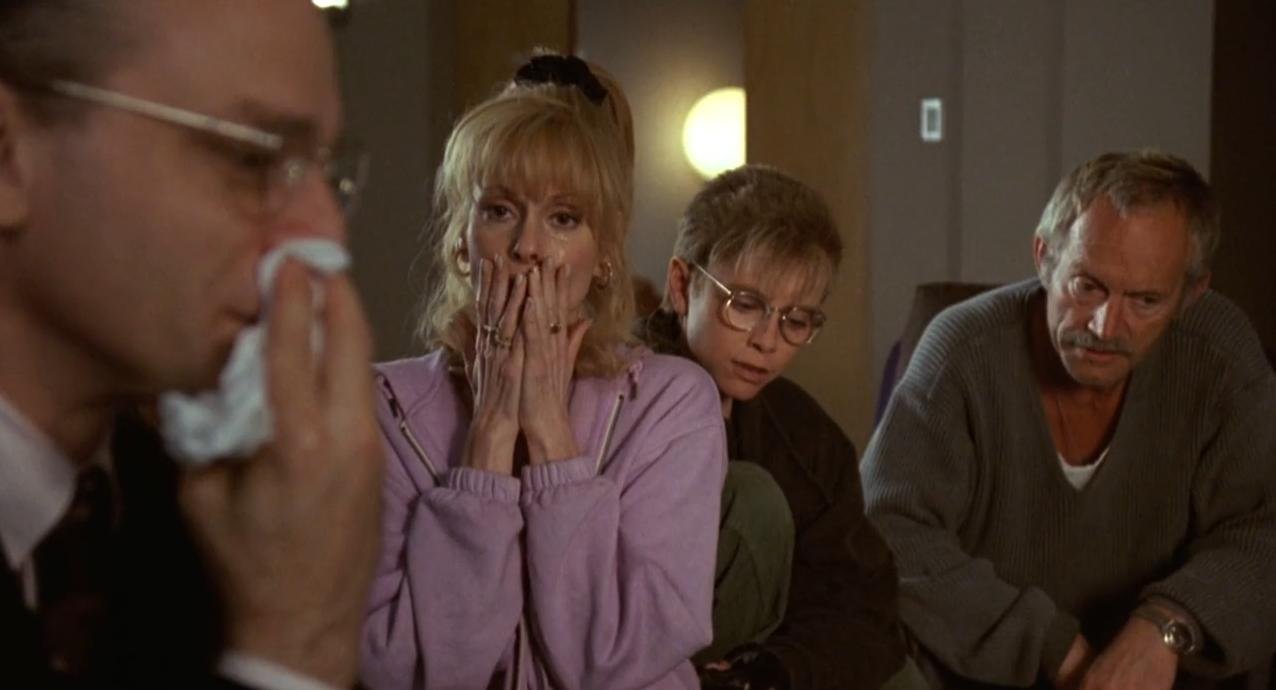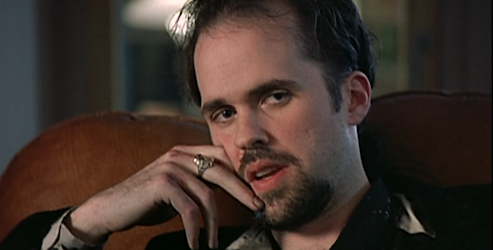In Honor of Brad Dourif Month, I'm Rerunning This Piece on 1994's Color of Night
Welcome, friends, to the latest entry in Control Nathan Rabin 4.0. It’s the career and site-sustaining column that gives YOU, the kindly, Christ-like, unbelievably sexy Nathan Rabin’s Happy Place patron, an opportunity to choose a movie that I must watch, and then write about, in exchange for a one-time, one hundred dollar pledge to the site’s Patreon account. The price goes down to seventy-five dollars for all subsequent choices.
I’m usually way behind on work so it’s nice sometimes to be able to plan WAY ahead. Accordingly, I have already decided that 2024 will be devoted to an exhaustive exploration of the magical movie year 1994, when Cabin Boy, Ace Ventura: Pet Detective, Reality Bites, Four Weddings and a Funeral, The Hudsucker Proxy, The Ref, Clifford, Red Rock West, Serial Mom, Lion King, PCU, Crooklyn, Fear of a Black Hat, Speed, Wolf, Forrest Gump, True Lies, Fresh, Natural Born Killers, Quiz Show, The Shawshank Redemption, Ed Wood, Hoop Dreams, Pulp Fiction, Clerks, Wes Craven’s New Nightmare, Bullets Over Broadway, The Last Seduction, Stargate, Heavenly Creatures, The Professional, Mrs. Parker and the Vicious Circle, Dumb and Dumber, Little Women, Nobody’s Fool, Chungking Express and Timecop were all released.
It’s a testament to how unbelievably stacked 1994 was in terms of memorable movies that Richard Rush’s cult classic Color of Night did not make the list I assembled of notable movies from that incredible year for my article on Timecop.
As anyone who has seen it can attest, Color of Night is not exactly what I would describe as a good movie, although it possesses an artistry and visual sophistication at times that belies its status as utter, delirious trash.
Color of Night is astonishingly the only film Richard Rush directed after his towering 1980 masterpiece The Stunt Man. Isolated moments throughout the film betray that this is the work of a true auteur, a genius capable of genuine greatness when he is not single-mindedly focused on seedy exploitation.
Rush’s keen eye for composition and framing is evident in the unforgettable opening scene, in which Dr. Bill Capa (Bruce Willis) challenges fragile, neurotic patient Michelle (Kathleen Wilhoite).
She responds to the doctor’s harshness and suggestion that she look at herself in the mirror by nervously insisting, “I prefer the view outside,” then racing across his office so that she can hurl herself through a window and plunge to a bloody death below.
It’s a gut punch of an opening. There’s an unexpected lyricism to the image of the poor woman falling endlessly to her doom, her scarf waving helplessly in the wind as she embraces total oblivion.
It’s an experience that leaves an indelible mark on the shrink in both predictable and unpredictable ways. The incident leaves him depressed and shaken, as well as overcome with guilt and shame. But it also, wonderfully, if inexplicably, renders him color-blind but only for the color red.
#Squad Goals #ThenewDreamTeam
The tortured hero’s highly specific color blindness is the kind of detail that makes Billy Ray and Matthew Chapman’s screenplay so distinctively insane. Color of Night is the first produced screenplay of a solid pro who would go on to write Shattered Glass, The Hunger Games, Captain Phillips, Richard Jewell, and the AMC ads about the wonders of cinema starring Nicole Kidman. Chapman, meanwhile, is Charles Darwin’s great-great-grandson. That has nothing to do with Color of Night but is a pretty nifty piece of trivia.
The troubled doctor goes to Los Angeles to visit his old friend and colleague Bob Moore (Scott Bakula), but when his college buddy is brutally murdered, he decides to stick around and essentially take over his life.
He moves into the dead man’s home, drives his car, and takes over his position leading a support group populated by some of the kookiest, most beloved character actors in American film.
Dourif!
Brad Dourif IS Clark, an uptight Poindexter with the most cartoonishly over-the-top case of Obsessive Compulsive Disorder in film history. Lance Henricksen, meanwhile, is brooding macho man Buck, a cop with a dead wife and kid and the same damn secret as everyone else in the group, including the shrink.
Leslie Anne Warren competes fiercely in the film’s Overacting Olympics in the juicy role of Sondra Dorio, a nymphomaniacal space cadet who radiates kooky, horny desperation, and Kevin J. O’Connor is a bohemian artist who creates “art” less designed to be looked at or admired than to facilitate frenzied masturbation: fetish paintings of women in bondage gear.
Last but not least, except for in the talent and professional achievement department, is SOMEONE as Ritchie, a stuttering, stammering, diminutive, suspiciously pretty boy child with coke bottle glasses who barely seems capable of holding a conversation with anyone but has a secret life that overlaps considerably with the secret lives of everyone else in the group.
Stop reading if you don’t want the infamous twist of a twenty-nine-year-old movie notable primarily for both a sex scene Maxim dubbed the greatest of all time AND for having one of the stupidest twists in film history.
That’s because Ritchie is played by model-turned-actress Jane March, who also stars as Rose, a beautiful, barely legal figure of mystery who swoops into our hero’s life unexpectedly, fucks his brains out in sex scenes of tremendous quantity and quality, and then slips away into the night mysteriously.
March plays both of these roles because (BUM BUM BUM) Ritchie and Rose are the same person! The enterprising young changeling isn’t just having sex with our hero. She’s having sex with EVERY member of the group AND both of the shrinks who led it, including the dead one. And NONE OF THEM realized that they were having sex with someone who was a member of their therapy group in their other identity OR that they were being cheated on with pretty much their entire social circle/support group.
Color of Night makes the worst possible case for group therapy. Everyone seems to hate everyone else and it doesn’t seem possible that any of them will get any better swimming around in such scummy, toxic, polluted waters.
I don’t want to be critical of the Hollywood geniuses who wrote the screenplay, but there are moments throughout Color of Night that lack verisimilitude.
Re-watching The Color of Night, I came to the realization that it’s a most peculiar Manic Pixie Dream Girl movie because it belongs to a sub-genre—sordid psycho-sexual shocker—that would seemingly prove a poof fit for the archetype AND because the film’s Manic Pixie Dream Girl doesn’t just enter the life of a depressed sad sack and fill it with joy, sex, excitement and eccentricity: she sweeps into the humdrum existences of a whole BUNCH of dudes and at least one woman.
Just about the only character in the film Rose (a Manic Pixie Dream Girl name if ever there was one) is not shtupping is Hector Martinez (Ruben Blades), a dogged detective with sexy secrets of his own who is trying to bully and insult Dr. Bill Capa into helping him find his friend’s killer.
Blades is a dark horse contender in the fierce battle to determine which of these world-class character actors can overact the most egregiously and delightfully. He’s a real character played by a real character actor who refers to Capa’s patients, and basically anyone who wrestles with mental illness or seeks professional help, either as a daffodil or a wombat.
Why a daffodil or wombat? I have no idea! But it’s colorful in a way that sticks out long after you’ve forgotten the details of less iconic fare.
From the director to the screenwriters to the cast, Color of Night is the work of supremely talented professionals whose artistry elevates lurid trash to the level of pop art. Color of Night has resources Rush never could have dreamed of when he was cranking out exploitation movies for AIP but he clearly held onto the gleefully exploitative trashiness of his early directorial output.
Color of Night really does not need to be one hundred and forty minutes long. At that length it’s entirely too much of a good-bad thing but it’s also very easy to see why it’s gone on to attract a sizable and devoted cult, and not just among deranged onanists.
Rush’s final film is a wildly entertaining, wildly excessive exercise in primo self-parody from people who knew exactly what they were doing.
Having covered Color of Night for My World of Flops and Control Nathan Rabin 4.0, I probably will not revisit it for my big 1994 project next year. That’s okay. After four or five viewings, I think I’ve gotten everything I need from it. It’s what my college professor would call textually rich, but I don’t know that it contains any more wonders for me at this point.
Nathan needed expensive, life-saving dental implants, and his dental plan doesn’t cover them, so he started a GoFundMe at https://www.gofundme.com/f/support-nathans-journey-to-dental-implants. Give if you can! It’s Christmas, after all, the most










